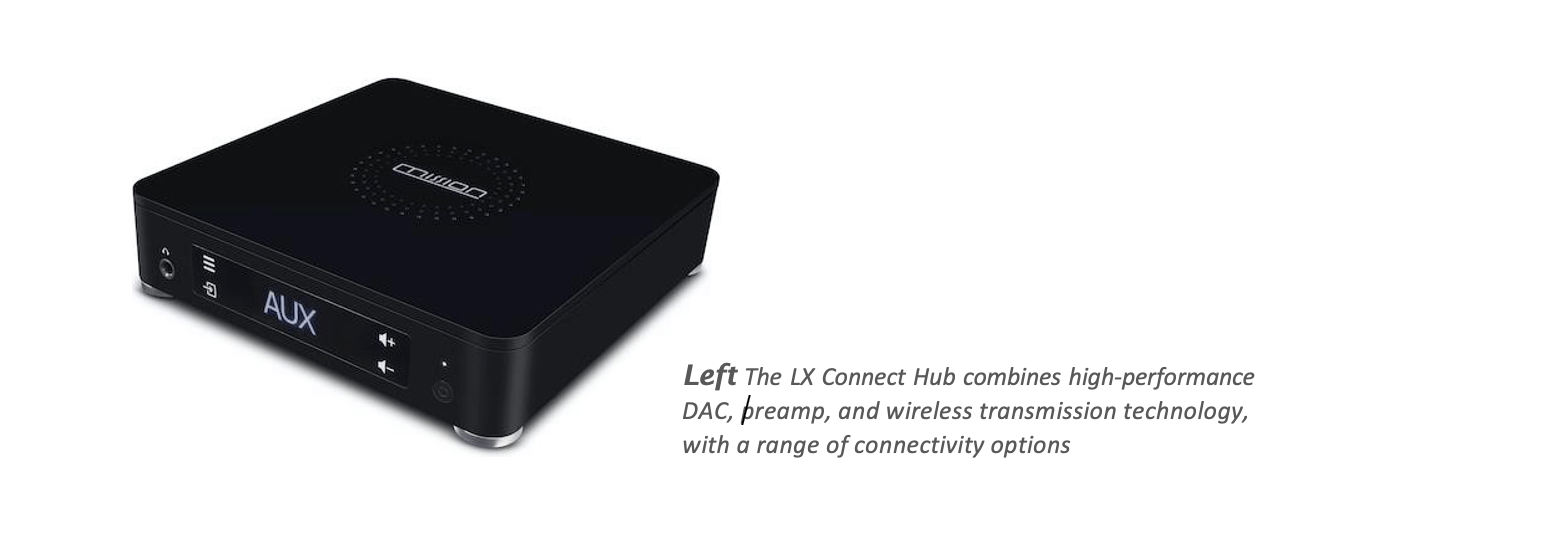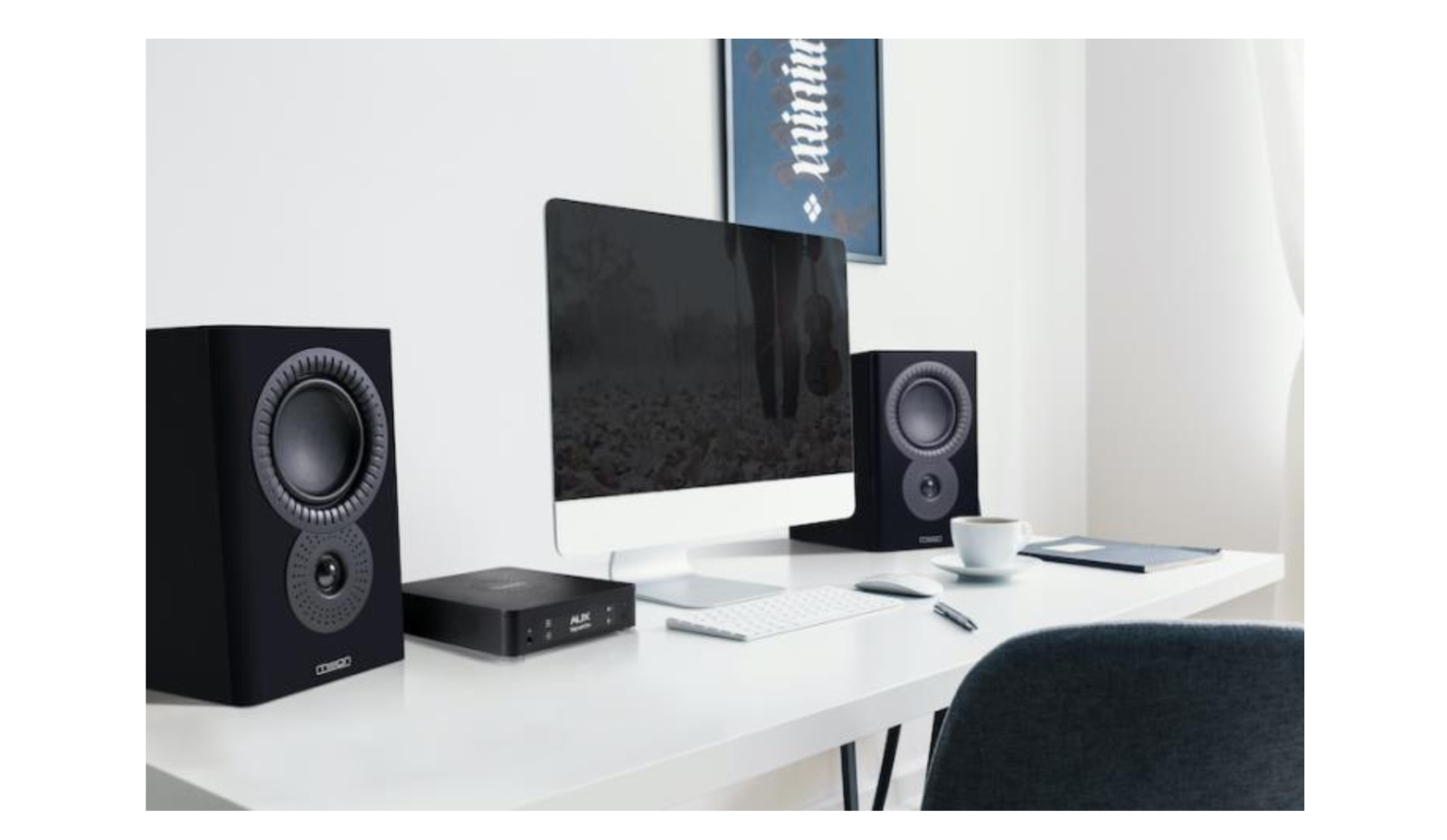British loudspeaker manufacturer Mission has released a new stereo wireless speaker system called the LX Connect. Combining acoustic engineering by Mission and electronic design by Audiolab, the Mission LX Connect is a compact hi-fi system branded with the convenience of wireless speakers, by fusing the convenience of a cable-free speaker connection with the functionality and sound quality of a high-performance hi-fi system.

Central to the LX Connect’s design is the LX-2 MkII – a pair of Mission speakers launched in 2020 as part of the LX MkII series. The LX-2 MkIIs are traditional ‘passive’ hi-fi speakers, designed to be connected via speaker cables to an amplifier. To create the LX Connect, Mission has taken the LX-2 MkII, enhanced its design and added a suite of high-performance technologies to create an active wireless speaker system with a unique range of attributes.

There are many different types of stereo wireless speakers on the market. Some connect wirelessly to a source device – a smartphone or computer, say – but have cables between them, with one primary speaker feeding the signal to the other. Mission states the LX Connect, offers ‘true wireless’ stereo with fully wireless transmission that removes a need for a connecting cable between the speakers – but most of these designs cram all the electronics into the speakers themselves resulting in inevitable compromise. There are also limiting factors in terms of positioning; for example, you may be restricted by the length of the cablebetween the speakers, or you may want to hook up a cable from your source device – USB from a computer for hi-res audio, for example – and therefore need to run a cable to one of the speakers from wherever the device is situated.
The LX Connect is different. It incorporates a third box –called the “hub”. Source devices connect to the Hub, which transmits the audio signal wirelessly to the two speakers via uncompressed Wi-Fi. The speakers themselves have no cables, other than a powercord to connect them to the mains. This inclusion of a separate Hub has enabled Mission to optimize the LX Connect’s audio circuitry and provide facilities that would be impossible to integrate or awkward to access without it. It connects to source devices – PCs and Macs, Android and iOS devices, music players, media boxes and so on – via asynchronous USB, S/PDIF (coaxial and optical) and HDMI digital cable connections, or wirelessly over Bluetooth. There is no built-in Wi-Fi networking – this is to maintain operational simplicity, without requiring a dedicated app (which are often not entirely satisfactory), and to avoid the potential instability of relying on a busy home Wi-Fi network. Instead, simply connect the Hub to a computer or smart device on your homenetwork and use your preferred streaming app to drive the LX Connect.

The Hub itself is a compact unit (55x235x231mm), easy to station conveniently near any source device. This might be a desktop or laptop computer, or perhaps a tablet, connected to the Hub via USB or Bluetooth. Or it could be a TV, media box or games console in an AV environment, hooked up via the Hub’s HDMI ARC input. It even includes a line- level RCA-stereo analogue input, so you could connect a CD player, say, or a turntable (with the addition of an offboard phono stage).
Mission has utilised the audio electronics expertise of sister-company Audiolab, maker of many award-winning DAC and amplifier components, to create the Hub. It incorporates a high-performance DAC stage based around the ES9018K2M DAC chip from theSabre32 Reference family, accompanied by proprietary circuitry to make the most of ESS Technology’s 32-bit HyperStream architecture and Time Domain Jitter Eliminator for ultra-low noise and high dynamic range.
The DAC stage supports hi-res PCM up to 32-bit/384kHz over USB and 24-bit/192kHz via the coaxial and optical inputs; DSD (up to DSD256) is also supported over USB. An RCA-stereo output is provided with fixed and variable output options, fed by a high-quality analogue stage – this enables the Hub to perform as an off-board DAC/preamp to connect to an external amplifier, or feed an active subwoofer to augment the LX Connect speakers. A high-quality headphone amp is also included, again derived from Audiolab – with its current-feedback circuitry, excellent gain bandwidth and high slew rate, a dynamic and detailed performance withall manner of headphones is assured.

Bluetooth reception complies with the Bluetooth 5 standard for optimum quality, reliability and range, and includes decoding for aptX HD,aptX LL (for AV media), regular aptX, AAC and SBC.
The two LX Connect active speakers can be placed up to 20m away from the Hub, wherever the user desires. The Hub transmits wirelessly on frequencies between 5.2GHz and 5.8GHz, switching automatically to ensure a stable connection and eschewing the crowded 2.4GHz band to avoid interference. The Hub can transmit hi-res audio up to 32-bit/192kHz to the speakers – impressivefor wireless speakers at any price level – with fully optimized time alignment for perfect stereo.The uncompressed Wi-Fi signal from the Hub is processed within the speakers by Mission’s Music Connect signal processing technology and passed to the 60W Class D amp circuitry that resides in each speaker, delivering ultra-lowdistortion and detailed, engaging sound. Music Connect also allows the user to select optional EQ adjustments. ThreeBass EQ settings allow for stand mounting (0 default), close to rear wall siting and/or shelf mounting (-6dB), and free-space positioning (+6dB), adjusted by a switch on speakers’ rear panel. In addition, the user can select Music or Movie mode via the Hub – Music offers the optimal balance for audiophile listening while Movie offers a mild enhancement of bass andmidrange to bring dialogue and effects to life when watching films or TV.
Further sonic tailoring options can be applied via the Hub, including a choice of three digital filters and four DSD bandwidthsettings (applicable to the stereo-RCA and headphone outputs), left/right channel balance and adjustable delay – to sync a subwoofer with the LX Connect speakers, for example. The Hub includes an OLED display with adjustable brightness and can be controlled using the included remote or by touch-sensitive controls on the unit itself.
The LX Connect speakers receive the benefit of Mission’s acoustic engineering expertise, finely honed over almost 45 years of loudspeaker design. Like the LX-2 MkII passive speakers on which they are based, the drive units are positioned according toMission’s Inverted Driver Geometry (IDG), with the bass/mid driver sited above the treble unit rather than below to aid time-alignment – a Mission trademark since the 1980s.
The 130mm bass/mid driver is a new version of Mission’s DiaDrive bass/midrange unit, where the usual cone and dust cap arrangement is replaced by a seamless curvilinear diaphragm. This is driven directly by a secondary sub-cone connected to the voice coil, improving the efficiency of drive and providing superior control of the smoothly dished diaphragm.
The diaphragm itself is fashioned from an advanced dual-layer fiber formulation, selected for its reduced susceptibility to hygroscopy as well as being very stiff for its mass with excellent self-damping, while the driver surround incorporates ‘comb-tooth’ serrations to help scatter interfering reflections. A high-strength ferrite magnet ensures that the magnetic field is directed precisely within the area of voice coil excursion, enabling an ultra-linear performance and excellent transient response.
The treble unit incorporates a neodymium magnet and 25mm microfibre dome, combining to deliver sweetly incisive high frequencies – crisp and detailed with impressive transient attack. Modelled closely to the acoustic performance of the LX2 MkII, the two drivers are knitted together seamlessly by a 2nd order (12dB per octave acoustic) Linkwitz- Riley DSP-managed crossover,developed with advanced computer modeling and many hours of listening tests.
The drivers are housed in a cabinet measuring 305hx200wx250mm deep, the same size and construction as the LX-2 MkII.Differences are more apparent around the back, with the LX-2 MkII’s single reflex port replaced by two smaller ports above a range of sockets and controls. Here reside a power switch and IEC socket, a USB update port, the bassadjustment switch and buttons for Hub pairing and left/right balance sync. A further switch designates each speaker as left or right in a stereo pair or switches the speaker to mono, enabling the speakers to go solo in a simple multi-room set-up.
The Roon platform has become the standard-bearer for high-quality digital music management and streaming. The LX Connect isofficially ‘Roon Tested’, meaning it has been put through its paces rigorously by Roon and certified for use in a Roon audioenvironment – for example, when connected to a PC or Mac running Roon software. LX Connect purchasers not yet using Roonbut interested in trying the platform can get a free 60-day trial by registering at mission.co.uk.
The LX Connect is defined by a marriage of virtues, brought together and fine-tuned by Peter Comeau, Mission’s world-renowned Director of Acoustic Design. The combined skills of Mission and Audiolab, delivering an expertly engineered bridge between classic hi-fi speakers and contemporary digital lifestyles. The class-leading quality of the speakers, with their traditional ‘bookshelf’ proportions and compelling sonic ability, married to active wireless convenience. The technology, simplicity and versatility broughtto the table by the Hub, making the LX Connect more of a compact hi-fi system with wireless connectivity than a pair of wirelessspeakers.
The Mission LX Connect wireless speaker system is available from October at $1999.99. The speakers are available in a choice ofsmart, contemporary soft-touch matt black or white, and the Hub comes in black.









